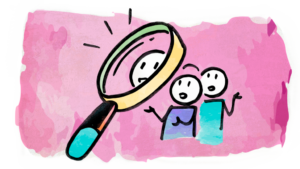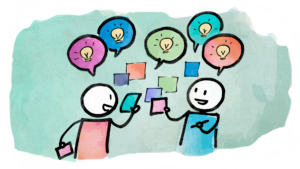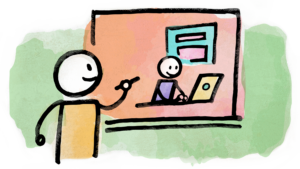There’s a language people are using more and more to bring their meetings, presentations, and workshops to life. It’s called “sketchnoting” or “graphical recording.” Sounds complicated, right? Here’s the good news: whether you know it or not, you already know this language.
Let’s take a look at the benefits of sketching, the reasons why it’s so effective, and how you can easily build your sketching “vocabulary” to the benefit of your organization – and yourself.
Bringing ideas into focus
We’ve all been in meetings that go around and around in circles. One way to focus the conversation is to use visual images to align participants. For example, let’s say you’re discussing a customer problem; in addition to using words to describe it, think about what the problem would look like. Then sketch a visual representation of the problem – from a human, authentic viewpoint – to focus your participants’ understanding and empathy. (If you’re thinking to yourself, “But I can’t draw,” stay with me! We’ll get to that.)

Keeping it simple
I’ve seen simple sketches do wonders; drawings of circles, squares, lines, and even stick figures make ideas more memorable and help inspire group creativity. When people see an image that resonates with them, they become more open to focusing on the problem at hand. A visual can help the viewer get to the core of the issue faster than just looking at a wall of words or a list of bullet points.
Here’s why it works: The human brain processes visual information 60,000 times faster than text … and because pictures are a universal language, they’re able to bypass barriers to understanding.
I’m not saying words aren’t important. In fact, the most effective sketches – whether they’re drawn on a whiteboard or a flip chart – incorporate words that clarify and expand on the visuals. That’s why you’ll always want to use the right mix of words and pictures.
Sketching for success
Here’s a hot tip if you have a lot to cover in a brainstorming session or meeting. Prepare your whiteboard and/or flip charts ahead of time … but not completely. Sketch out your ideas so you have 50% of the information you’ll present already on your whiteboard or flipchart. This way, when you get into your session, you can simply fill in the points as you go.
Case Study 1: Creating consensus. We were working with SAP Ariba to develop a strategy for a new mid-market product. At our kickoff meeting, we used simple sketching to help focus everyone on the team’s goals and the problems they were trying to solve. The resulting visuals helped the team stay on track; as they worked, they often referred back to the sketches. The graphical recordings helped team members feel heard, and that allowed them to come to a consensus faster and easier.
Case Study 2: Making memories. I gave a presentation on facilitation to a large tech company’s innovation team, using just a few cards with highlights. I sketched some drawings on sticky notes; one of the favorites was the coffee cup and donut I drew to illustrate the point that you can energize your team with food and drinks if you’re having a long facilitation meeting. The team told me the sketches made a huge difference in their ability to remember the points we covered (and those who were worried they’d forget took pictures of the drawings!). The sketches made much more of an impact than just another PowerPoint would have.
Case Study 3: Spinning stories. When the QuickBooks Enterprise marketing team launched a “New to the Franchise” content effort, they brought together a cross-functional group of 30 people, all from different backgrounds and countries. Using simple sketching, we were able to rally the team around customer personas; customer journeys came alive before their eyes. Simple drawings kept the team on track and focused them on thinking creatively. The images helped to keep the team’s energy up and the momentum going throughout the full day session.

“But I can’t draw!”
We hear this so many times from people! Our response? “You’re already drawing, every day!”
When you write letters, you’re drawing lines and squiggles that have meaning. From there, you’re able to combine letters to make words and combine words to make sentences. Simple sketching is the same, you start with lines and squiggles and build “letters” that combine to make “words” and “sentences.”

Our quick PDF drawing guide will show you how to add to this skill set by learning how to draw simple symbols, including people and faces. Chances are, you’re already on your way to becoming more of a visual thinker — this happens every time you text an emoji. When you combine your language skills with the ability to create icons and metaphors from scratch, you’ll be able to convey ideas in meetings and presentations quickly and simply.
Download our quick PDF drawing guide to get started on the basics of simple sketching. I created this handy starter guide with visuals from one of my partner graphical recorders, Deb Aoki. (You can learn more about her work at http://www.debaoki.com.)
Drawing conclusions
Just keep drawing, and your visual vocabulary, speed, and creative confidence will grow. So will your ability to collaborate and share your ideas in a fun and memorable way. If you give this a try, let me know. I’d love to hear how it goes!

